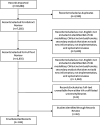Delivery of Complementary and Integrative Health Using Virtual Health Resources: A Scoping Review
- PMID: 35819410
- PMCID: PMC9700349
- DOI: 10.1089/jicm.2021.0458
Delivery of Complementary and Integrative Health Using Virtual Health Resources: A Scoping Review
Abstract
Introduction: Complementary and integrative health (CIH) modalities promote overall health and well-being and can be beneficial for individuals with a range of conditions. Traditionally, CIH has been delivered in person. COVID-19 created a need to identify sustainable remote delivery options to assure access to CIH while practicing public health recommendations. This scoping review maps the opportunities and challenges to remotely delivered CIH. Materials and methods: A scoping review was conducted between June 2020 and October 2020 using the following search engines: PubMed, Academic Search Premier, PsycINFO, CINAHL, Cochrane Reviews, and the Cochrane Clinical Trial Collections. Search results investigating remote CIH delivery were restricted to articles written in English, published after 1990. Results: Of the 10,884 articles identified, after review for content and methods, 330 articles were included. Most articles were randomized controlled trials (n = 170), applied mindfulness (n = 203), and targeted mental and behavioral health conditions (n = 182). Interventions were primarily delivered through mobile applications (n = 151) and web-based platforms (n = 86). Most commonly reported barriers were adherence (n = 24), resource requirements (e.g., time and space) (n = 23), and technology-related issues (n = 21). Although most studies did not report facilitators (n = 217), most commonly reported facilitators were social and technologic supports, accessibility, usability, perceptions, and rewards. Participant outcomes measured were broad and included movement (n = 88), stress (n = 68), and pain (n = 54). Intervention characteristic outcomes most often measured were satisfaction and usability (n = 5). Conclusions: This scoping literature review identified many articles addressing remote delivery of CIH, but few reporting on the implementation of remotely delivered CIH. Findings suggest remotely delivered CIH, specifically mindfulness and meditation-based modalities, is a viable treatment option for a diverse range of health conditions. Feasibility studies and larger sample sizes are recommended to strengthen the scientific evidence.
Keywords: complementary and integrative health; health care; health delivery; remote delivery; scoping review.
Conflict of interest statement
No competing financial interests exist.
Figures



Similar articles
-
Outcomes of a Remotely Delivered Complementary and Integrative Health Partnered Intervention to Improve Chronic Pain and Posttraumatic Stress Disorder Symptoms: Randomized Controlled Trial.J Med Internet Res. 2024 Oct 18;26:e57322. doi: 10.2196/57322. J Med Internet Res. 2024. PMID: 39422992 Free PMC article. Clinical Trial.
-
Mobile and Web-Based Partnered Intervention to Improve Remote Access to Pain and Posttraumatic Stress Disorder Symptom Management: Recruitment and Attrition in a Randomized Controlled Trial.J Med Internet Res. 2023 Oct 3;25:e49678. doi: 10.2196/49678. J Med Internet Res. 2023. PMID: 37788078 Free PMC article. Clinical Trial.
-
Beyond the black stump: rapid reviews of health research issues affecting regional, rural and remote Australia.Med J Aust. 2020 Dec;213 Suppl 11:S3-S32.e1. doi: 10.5694/mja2.50881. Med J Aust. 2020. PMID: 33314144
-
Documentation of Complementary and Integrative Health Therapies in the Electronic Health Record: A Scoping Review.J Integr Complement Med. 2023 Aug;29(8):483-491. doi: 10.1089/jicm.2022.0748. Epub 2023 Mar 10. J Integr Complement Med. 2023. PMID: 36897742
-
Synchronous Web-Based Psychotherapy for Mental Disorders From a Health Quality Perspective: Scoping Review.J Med Internet Res. 2023 Nov 3;25:e40710. doi: 10.2196/40710. J Med Internet Res. 2023. PMID: 37921863 Free PMC article.
Cited by
-
Outcomes of a Remotely Delivered Complementary and Integrative Health Partnered Intervention to Improve Chronic Pain and Posttraumatic Stress Disorder Symptoms: Randomized Controlled Trial.J Med Internet Res. 2024 Oct 18;26:e57322. doi: 10.2196/57322. J Med Internet Res. 2024. PMID: 39422992 Free PMC article. Clinical Trial.
-
Feasibility and Usability of EnergyPoints: A Mobile Health App to Guide Acupressure Use for Cancer Symptom Management.Integr Cancer Ther. 2024 Jan-Dec;23:15347354231223965. doi: 10.1177/15347354231223965. Integr Cancer Ther. 2024. PMID: 38284345 Free PMC article.
-
Models of Integrated Acute Care for Older Adult Inpatients That Incorporate Integrative Health: An Integrative Review.J Multidiscip Healthc. 2025 Feb 12;18:759-786. doi: 10.2147/JMDH.S505404. eCollection 2025. J Multidiscip Healthc. 2025. PMID: 39963327 Free PMC article. Review.
-
Mobile and Web-Based Partnered Intervention to Improve Remote Access to Pain and Posttraumatic Stress Disorder Symptom Management: Recruitment and Attrition in a Randomized Controlled Trial.J Med Internet Res. 2023 Oct 3;25:e49678. doi: 10.2196/49678. J Med Internet Res. 2023. PMID: 37788078 Free PMC article. Clinical Trial.
References
-
- Elwy AR, Taylor SL, Zhao S, et al. . Participating in complementary and integrative health approaches is associated with veterans' patient-reported outcomes over time. Med Care 2020;58:S125–S132. - PubMed
-
- Taylor SL, Herman PM, Marshall NJ, et al. . Use of complementary and integrated health: A retrospective analysis of US veterans with chronic musculoskeletal pain nationally. J Altern Complement Med 2019;25:32–39. - PubMed
-
- Giannitrapani KF, Holliday JR, Miake-Lye IM, et al. . Synthesizing the strength of the evidence of complementary and integrative health therapies for pain. Pain Med 2019;20:1831–1840. - PubMed
-
- Stephenson KR, Simpson TL, Martinez ME, Kearney DJ. Changes in mindfulness and posttraumatic stress disorder symptoms among veterans enrolled in mindfulness-based stress reduction. J Clin Psychol 2017;73:201–217. - PubMed
Publication types
MeSH terms
LinkOut - more resources
Full Text Sources
Medical
